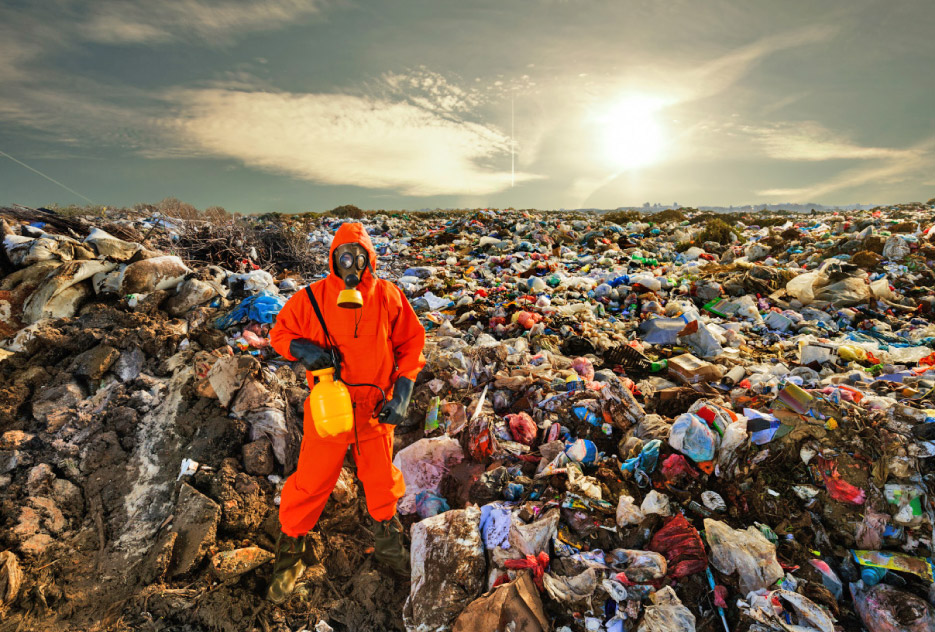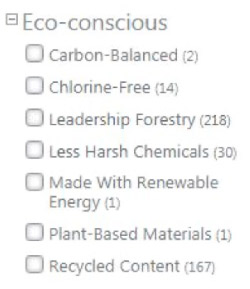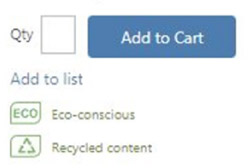Land and Our Environment
Sharon Koehler
Stone Industry Consultant
Whenever I fly, I always book a window seat. I love to look out the window and see the Earth go by. It’s a much different view than from a car window.
I had occasion to fly recently and I saw some beautiful things. Snow-capped mountains, beautiful evergreen forests, and a bird walking on frozen Lake Michigan. I am always in awe of nature’s wonders.
Along the way I did spot something that wasn’t quite so pretty. I spotted a huge landfill. It wasn’t the landfill itself that caught my attention, it was the land around it. The land around it was just dead. No trees, no grass, and it had a sick brownish color to it. Not winter dead, but dead-dead. The land surrounding the landfill was polluted and nothing was growing on it.
Land pollution is described as “The presence of toxic chemicals (pollutants or contaminants) in soil, in high enough concentrations to pose a risk to human health and/or the ecosystem.

Man-made waste is the number one reason for land pollution, and we do it in so many different ways that it’s hard to keep track.
- Gasoline spills at gas stations
- Using non-organic pesticides and insecticides
- Mining
- Sewer line leakage
- Industrial pollution from manufacturing and spills
- Farming– pesticide runoff.
- Air pollution (Pollutants in the air eventually settle on the earth. What is bad for the air is also bad for the land.)
- …And the list goes on.
If the land is polluted, plants and trees don’t grow, which reduces the earth’s oxygen levels. Contaminated land produces less crop growth and produces less healthy plants, reducing our food levels. During storms, polluted land can run off into rivers and streams, affecting marine life and water supplies. It’s hard to catch fish for dinner when the fish are dead!
Animals (like cows) that eat grass grown on polluted land may become sick and unfit for humans to eat. Again, this is lands pollution affecting our food levels. According to Responsible Business, 95 percent of our global food comes from soil, and 33 percent of our global land is already contaminated.
 Besides chemicals, solid manmade waste is one of the biggest contributors to land pollution. This includes, but is not limited to things like construction debris, garbage, used electronics, and tires.
Besides chemicals, solid manmade waste is one of the biggest contributors to land pollution. This includes, but is not limited to things like construction debris, garbage, used electronics, and tires.
There are things that businesses can do to help stop land pollution.
Look for Eco Conscious, Recycled Content, Elemental Chlorine Free or Forest Stewardship Council (FSC) on the supplies you purchase for office use. Some office supply stores are even putting recycled or less harsh chemicals in their filters.
More recycled content means less solid waste.
Some suppliers are putting the labels out there where you can see them, so you know your company is helping the cause
For example: here’s is the label from a case of copy paper: 100% Recycled FSC® Certified. (FSC Certified means that all wood or paper in the product is reclaimed/reused.)
Not only that, but in the description of the copy paper they state that they are Elemental Chlorine Free, as well.
It only takes a minute of reading to see what your office is buying.
 Another way to help stem the tide is to consider taking your office paperless. With apps like DocuSign and GoCanvas, instead of a filing cabinet, your storage is in the cloud, including email. If more companies used it, we should be able to significantly reduce the amount of paper used, therefore reducing the solid waste in landfills. Bank of America committed to going paperless back in 2018. It’s worth a thought.
Another way to help stem the tide is to consider taking your office paperless. With apps like DocuSign and GoCanvas, instead of a filing cabinet, your storage is in the cloud, including email. If more companies used it, we should be able to significantly reduce the amount of paper used, therefore reducing the solid waste in landfills. Bank of America committed to going paperless back in 2018. It’s worth a thought.
If you have your indoor office or outside landscaping sprayed for pests, request organic sprays like Pyrethrum (made from a type of Chrysanthemum flower) or Neem oil (which comes from the Neem tree). Using organic treatments means that thrown out mop water or rain run off won’t carry harmful pollutants to nearby soil or streams.
Snow/ice melt is another area that deserves consideration. Instead of treating your sidewalks with environmentally harsh chemicals that can run off into the soil, consider a greener, more eco-friendly product that doesn’t harm the soil. The one I use is a corn-based product mixed with magnesium chloride. (Magnesium chloride sounds bad, but it can be found in the supplement aisle of just about every drug store, just like vitamins, fish oil, iron or calcium). It is kid- and pet-friendly and it is safe for concrete and surrounding plant life.
Individuals can help with land pollution as well;
- Don’t litter – that plastic wrapper or cigarette butt that lands on the ground can leach toxic chemicals into the soil. Remember, it’s not only you but thousands if not millions of other folks missing the trash can, too.
- If you have a home garden, use organic weed killers. They are available at a wide variety of big box stores.
- Use organic pest killers, as well. Outside, you can lay down a barrier of diatomaceous earth. (in early spring, after the last snow but before the rains come, I lay down a barrier of diatomaceous earth all along the front, back and sides of my house as a deterrent to pests that want to get inside)
- Did you know that the essential oils you use in your home diffuser to make your home smell good are also excellent natural pest deterrents? A Eucalyptus oil and water spray mixture can be used for roach problems. Ants can be controlled with a mixture of water, peppermint oil and lemon oil. Flies can be driven away with Rosemary and a lavender – lemongrass mixture can be used to help repel fleas on your pets. Last year, my cat got fleas and I treated her and the house with a natural flea spray that had peppermint oil and eugenol. It worked, plus it wasn’t harmful to the cat or me.
We haven’t figured out how to live on the moon or on any other planet besides Earth, so we should probably figure out how to all be doctors of the earth and remember the words “First, do no harm.” The earth is all we got, let’s keep it healthy.
Please send your thoughts on this article to Sharon Koehler at Sharonk.SRG@gmail.com.